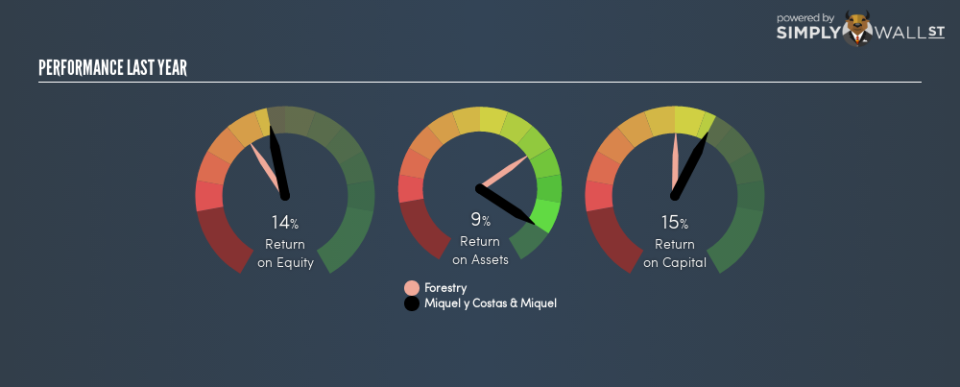Should You Like Miquel y Costas & Miquel, S.A.’s (BME:MCM) High Return On Capital Employed?

Want to participate in a short research study? Help shape the future of investing tools and you could win a $250 gift card!
Today we are going to look at Miquel y Costas & Miquel, S.A. (BME:MCM) to see whether it might be an attractive investment prospect. In particular, we’ll consider its Return On Capital Employed (ROCE), as that can give us insight into how profitably the company is able to employ capital in its business.
First of all, we’ll work out how to calculate ROCE. Then we’ll compare its ROCE to similar companies. And finally, we’ll look at how its current liabilities are impacting its ROCE.
Understanding Return On Capital Employed (ROCE)
ROCE is a metric for evaluating how much pre-tax income (in percentage terms) a company earns on the capital invested in its business. In general, businesses with a higher ROCE are usually better quality. In brief, it is a useful tool, but it is not without drawbacks. Author Edwin Whiting says to be careful when comparing the ROCE of different businesses, since ‘No two businesses are exactly alike.’
How Do You Calculate Return On Capital Employed?
Analysts use this formula to calculate return on capital employed:
Return on Capital Employed = Earnings Before Interest and Tax (EBIT) ÷ (Total Assets – Current Liabilities)
Or for Miquel y Costas & Miquel:
0.15 = €49m ÷ (€390m – €57m) (Based on the trailing twelve months to September 2018.)
Therefore, Miquel y Costas & Miquel has an ROCE of 15%.
Check out our latest analysis for Miquel y Costas & Miquel
Does Miquel y Costas & Miquel Have A Good ROCE?
When making comparisons between similar businesses, investors may find ROCE useful. Miquel y Costas & Miquel’s ROCE appears to be substantially greater than the 8.6% average in the Forestry industry. I think that’s good to see, since it implies the company is better than other companies at making the most of its capital. Independently of how Miquel y Costas & Miquel compares to its industry, its ROCE in absolute terms appears decent, and the company may be worthy of closer investigation.
Our data shows that Miquel y Costas & Miquel currently has an ROCE of 15%, compared to its ROCE of 12% 3 years ago. This makes us think about whether the company has been reinvesting shrewdly.
It is important to remember that ROCE shows past performance, and is not necessarily predictive. ROCE can be misleading for companies in cyclical industries, with returns looking impressive during the boom times, but very weak during the busts. ROCE is, after all, simply a snap shot of a single year. What happens in the future is pretty important for investors, so we have prepared a free report on analyst forecasts for Miquel y Costas & Miquel.
How Miquel y Costas & Miquel’s Current Liabilities Impact Its ROCE
Short term (or current) liabilities, are things like supplier invoices, overdrafts, or tax bills that need to be paid within 12 months. Due to the way ROCE is calculated, a high level of current liabilities makes a company look as though it has less capital employed, and thus can (sometimes unfairly) boost the ROCE. To check the impact of this, we calculate if a company has high current liabilities relative to its total assets.
Miquel y Costas & Miquel has total assets of €390m and current liabilities of €57m. Therefore its current liabilities are equivalent to approximately 15% of its total assets. A fairly low level of current liabilities is not influencing the ROCE too much.
Our Take On Miquel y Costas & Miquel’s ROCE
With that in mind, Miquel y Costas & Miquel’s ROCE appears pretty good. Of course, you might find a fantastic investment by looking at a few good candidates. So take a peek at this free list of companies with modest (or no) debt, trading on a P/E below 20.
If you are like me, then you will not want to miss this free list of growing companies that insiders are buying.
To help readers see past the short term volatility of the financial market, we aim to bring you a long-term focused research analysis purely driven by fundamental data. Note that our analysis does not factor in the latest price-sensitive company announcements.
The author is an independent contributor and at the time of publication had no position in the stocks mentioned. For errors that warrant correction please contact the editor at editorial-team@simplywallst.com.

